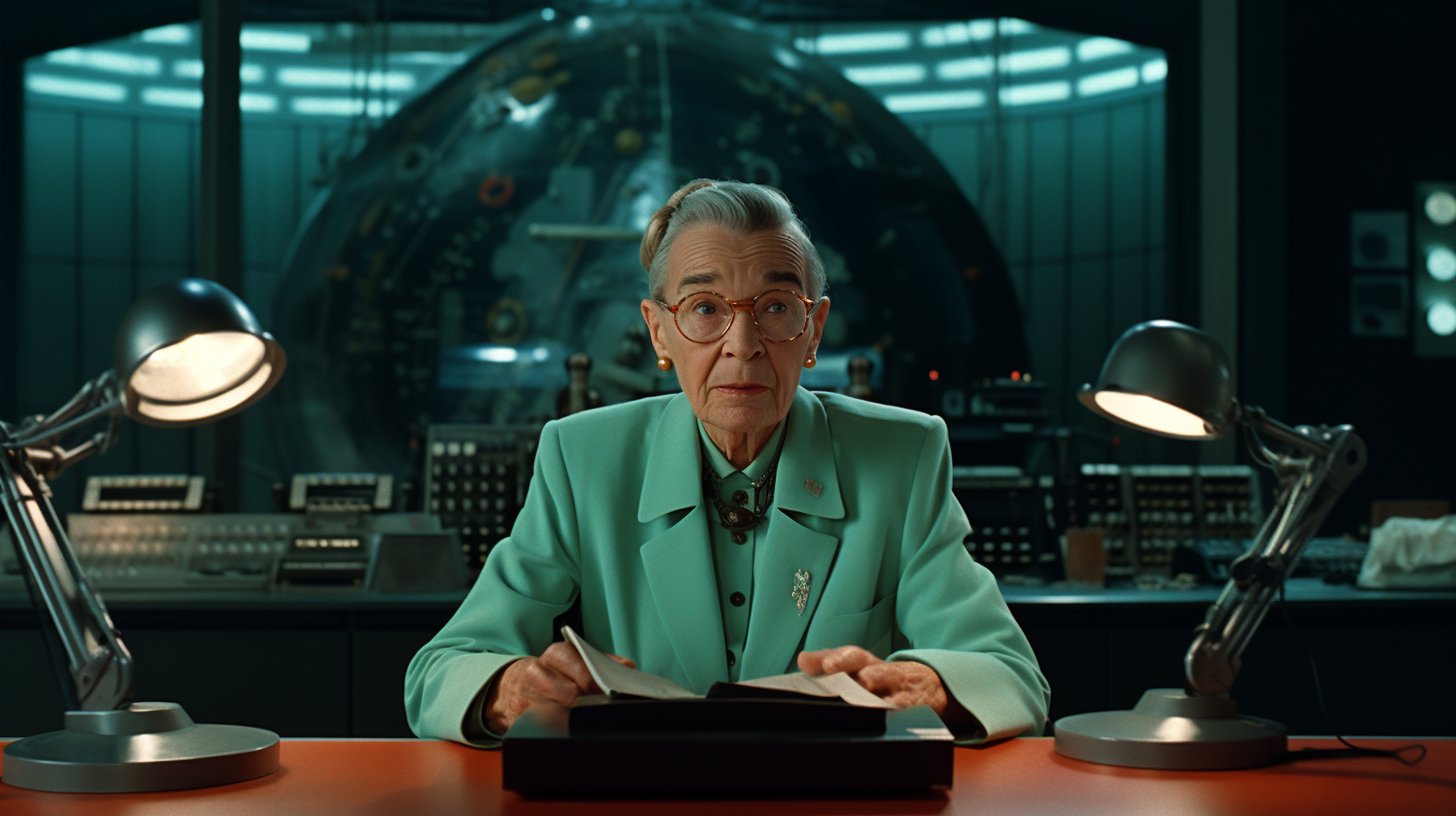Introduction
In the next installment of our series exploring pioneering figures in computer science, we turn to “Amazing Grace” Hopper. Grace Brewster Murray Hopper was a remarkable American computer scientist and United States Navy rear admiral. Her trailblazing contributions to computer programming, including the development of one of the first compiler programs, helped shape modern software engineering practices.
Born in 1906 in New York City, Hopper’s lifelong curiosity and aptitude for mathematics led her to new heights in the nascent world of computer science. Her work on the Harvard Mark I computer during World War II produced the first compiler, a program that translates high-level language into machine code. This pioneering innovation transformed programming, enabling the widespread use of common business languages.
Hopper’s accomplishments span decades of public and military service. She popularized the terms “bug” and “debugging” in computing, after a moth caused issues with the Mark II computer. Her leadership and advocacy of machine-independent programming languages was instrumental to the standardization of COBOL, a ubiquitous business language. The recipient of numerous accolades, including prestigious computing medals and naval commendations, Hopper’s contributions continue to influence modern computer science.
This article will delve into Grace Hopper’s background, her wartime work, and her enduring influence. We will explore some of her seminal innovations like the compiler, as well as her advocacy for practical programming languages. Hopper’s prescient vision and tireless spirit provide valuable lessons for aspiring computer scientists. Let us embark on a journey through the life of this truly amazing pioneer of computer programming.
A Brief Biography of Grace Hopper
Born in New York City in 1906, Grace Brewster Murray inherited a love of learning and mathematics from her mother and academic grandfather. She demonstrated remarkable intelligence from childhood, with interests ranging from engineering to dismantling alarm clocks. Hopper graduated at the top of her class from Vassar College in 1928 with a bachelor’s degree in mathematics and physics.
Pursuing her interest in mathematics, Hopper began doctoral studies at Yale in 1930. There she encountered early mathematical theories that would later influence her computing work. She completed her Ph.D. in mathematics in 1934. Though she later married Vincent Foster Hopper, her academic achievements foreshadowed her pioneering work in computing.
After her divorce, Hopper looked to resume her career. She taught mathematics at Vassar while also enlisting in the United States Naval Reserve in 1943. This began her lifelong association with the Navy, where she advanced over four decades from lieutenant to rear admiral.
It was also in 1943 that Hopper obtained a leave of absence from Vassar to join the war effort. Beginning work on the Mark I computer at Harvard University, her ingenuity led to breakthroughs like the first compiler, laying the foundation for modern software engineering. She would continue making significant contributions across both academia and the public sector throughout her long and storied career.
Hopper retired from the Naval Reserve in 1966 but was recalled to active duty. She retired again in 1971, only to be called back once more. Finally, she retired for good in 1986. These recalls emphasize the importance of her work to the Navy and could be highlighted.
Overview of Hopper’s Contributions
Grace Hopper’s innovations span foundational concepts like machine-independent programming and practical tools like compilers. She also advocated tirelessly for practical programming languages that resembled human languages. Let’s explore some highlights of her pioneering work.
The First Compiler
While working on the UNIVAC I computer, Hopper developed the first compiler program in 1952. This groundbreaking tool translated high-level programming language into machine code, enabling widespread adoption of common languages like COBOL. The compiler effectively shaped modern software engineering.
COBOL Standardization
Hopper championed the COBOL (Common Business-Oriented Language) programming language. Her advocacy was instrumental in standardizing COBOL across multiple platforms, facilitating practical business computing applications. This machine-independent language is still influential today.
Popularizing Terms Like “Bug”
Tracing a computer malfunction to an actual moth stuck in the Mark II hardware, Hopper helped popularize the terms “bug” and “debug” in technology. While the term ‘bug’ had been used before in engineering, her anecdote showcased her flair for bringing technical concepts to wider audiences.
UNIVAC and the First Commercial Computer
Hopper was highly influential in the development of the UNIVAC I (Universal Automatic Computer I), the first commercial computer produced in the United States. Her language compiler innovations enabled broader adoption of UNIVAC and other early computing systems.
A Pioneer in Programming Languages
Beyond COBOL, Hopper made significant contributions to ALGOL and FLOW-MATIC – early high-level languages. Her work helped shape the evolution from cryptic machine code to rich programming languages that more closely resemble natural human language. This evolution opened computing to wider audiences.
Lifelong Navy Service and Promotion to Rear Admiral
Hopper’s distinguished service spanned multiple decades in the Naval Reserves, Navy, and civilian roles. She was promoted to the rank of rear admiral (lower half) in 1985 at age 79, becoming one of the U.S. Navy’s few female admirals. She retired at age 80 with a well-earned reputation as an influential leader.
Deep Dive into Key Contributions
In this section, we will explore two of Grace Hopper’s most revolutionary accomplishments that left an indelible mark on the world of computer science. We first delve into Hopper’s pioneering work on the compiler, a groundbreaking tool that translated high-level programming language into machine code, shaping modern software engineering. Then we shall look at her instrumental role in the standardization and promotion of COBOL, a machine-independent language that democratized computing and became a cornerstone of business applications. Together, these in-depth explorations provide insight into the innovations that helped define Hopper’s enduring legacy.
The Compiler
Now let’s take a deeper look into Grace Hopper’s most revolutionary innovation – the compiler. Developed during her time working on the Mark I computer at Harvard in the early 1950s, this first-of-its-kind program transformed computer programming.
In essence, a compiler translates high-level programming language that is readable by humans into the machine code executed by computers. This eliminates the need for programmers to write long, complex code sequences in cryptic machine language. Instead, they can use languages like COBOL or FORTRAN that resemble natural human languages.
COBOL, the language Hopper extensively worked on, uses statements like “Add X to Y” that are intuitive for humans. The compiler software handles translating these logical instructions into the specific machine code operations needed to execute them, easing the programmer’s job tremendously.
The compiler enabled significant leaps in programming productivity and helped high-level languages proliferate. Before this innovation, each program had to be meticulously hand-coded in machine language, limiting computing’s accessibility. Hopper’s compiler effectively birthed modern software development.
Her visionary contribution shaped virtually all subsequent advances in programming languages and environments. The compiler pioneered an approach that allowed human-accessible languages and enabled portability across platforms. Hopper’s work allowed programming to scale beyond just the mathematically-inclined and brought business and scientific computing into the mainstream.
Standardizing COBOL
Grace Hopper’s advocacy and instrumental role in the standardization of COBOL (Common Business-Oriented Language) stand as one of her most impactful contributions to the field of computer science. Her vision of a machine-independent language that would enable practical business computing applications laid the groundwork for a new era in programming.
Hopper understood that the languages of the time were complex and not readily accessible to those without extensive technical training. Her experience with the FLOW-MATIC language, designed for business applications, fueled her belief in the need for a standardized language that would be both practical and universal.
In 1959, Hopper was part of the committee formed to develop COBOL. This committee comprised representatives from academia, industry, and the government, tasked with creating a common language that could run on different machines. Hopper’s advocacy for readability and user-friendly syntax was a driving force behind the language’s design.
COBOL was built to resemble English, with clear, verbose commands. This choice opened the doors to programming for many non-specialists, aligning with Hopper’s vision of democratizing access to computing. Statements like “Add X to Y” replaced complex machine code, making programming more intuitive.
Beyond initial development, Hopper played a crucial role in the standardization of COBOL. She understood that for COBOL to achieve its potential, it needed to be accepted across various industries and computing platforms. Hopper tirelessly promoted COBOL, emphasizing its potential to revolutionize business computing.
Under Hopper’s guidance, COBOL became a critical tool for business and government operations. By the late 1960s, it was the most widely used programming language in the world. Its standardization allowed for greater interoperability between systems, reducing costs, and increasing efficiency.
COBOL’s success is a testament to Hopper’s vision and leadership. Even decades after its inception, COBOL remains in use, especially within legacy systems in the financial and government sectors. Hopper’s emphasis on readability, standardization, and practical application has left a lasting imprint on the programming landscape.
Grace Hopper’s role in the creation and standardization of COBOL reflects her broader commitment to making computing accessible and practical. Her work in COBOL not only transformed business computing but also laid a foundation for programming principles that continue to resonate today. Her vision, advocacy, and relentless pursuit of a language for the people mark a pivotal moment in computer science, illustrating once more why she remains a revered figure in the field.
Conclusion
Grace Hopper’s trailblazing work over decades of public service established foundations that still underpin modern computer science. Her compiler innovation remains a pivotal milestone in enabling human-centered computing. Hopper also left an indelible mark through her advocacy of practical yet universal programming languages.
Hopper’s prescient vision, technical brilliance, and tireless leadership advanced computational thinking and possibility. She was a source of inspiration who encouraged engagement with computer science from a diverse range of people and disciplines. Grace Hopper’s storied life provides invaluable context and lessons for the future pioneers who will continue advancing human understanding through technology.
Next in the Series
In the next installment of our series on pioneering computer scientists, we will explore the life and work of Donald Knuth. His influential multi-volume series “The Art of Computer Programming” established core frameworks that underlie modern algorithm design and analysis. Stay tuned for a deep dive into Knuth’s contributions to algorithmic thinking, programming clarity, and the rigorous mathematical foundations of computer science.


